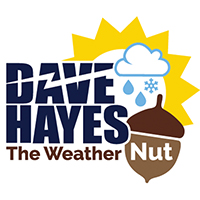Gusty straight-line winds can occur behind what is called a gust front, which is the boundary of air that separates warm humid air that the thunderstorm is entering into, and rain-cooled air along the leading edge of the thunderstorm, and under it as well. When a squall line is moving in, you often see dramatic looking clouds indicating the beginning of the thunderstorm, and the downward-arcing initial cloud is called a shelf cloud, which represents the dividing line of this air boundary change.
In more severe thunderstorms, microbursts can form, which are also straight-line wind events. The damage these events create is often mistaken for tornadoes, but microbursts are their own phenomena, which can cause damage similar to a tornado.
Severe thunderstorms are born when the following combination of factors are present: copious low-level moisture, air that is forced skyward, and atmospheric instability. Air being forced skyward is also known as lift, and is most commonly produced when cold fronts are approaching. Because the warm air ahead of them is less dense than the cold air behind them, as they approach, the air is forced skyward. Instability is usually represented by very warm moist air at the ground, and colder, drier air in the upper levels. Since warm air is less dense than cold air, this scenario fosters convection, which is a term that refers to a rising, buoyant warm air parcel through surrounding cooler air.
This setup produces very strong and powerful updrafts and downdrafts within the core of the thunderstorm. The rapidly descending downdrafts are formed from the substantial precipitation that is created, both in the form of liquid rain, and in some cases, frozen hail. This downdraft of rain and hail-cooled air, when organized enough, creates “drag” on the surrounding air, and begins to accelerate downward towards the ground. Upper air flows called jet streaks are thought to also be directed towards the ground as they get caught in these downdrafts as well.
As I saw on radar a few days ago, a classic bow echo (which looks like a C-curve) was present, which normally indicates the microburst.
As this rapidly sinking downdraft strikes the surface of the planet, it spreads out radially in all directions, with the most force and highest gusts being ahead of the storm, in the direction that it is traveling. For example, the gusts in the Whately/Sunderland microburst were determined to be 60 to 80mph, and indicated a northeasterly direction, which was the direction the thunderstorm was traveling. Microbursts can produce wind gusts in excess of 150mph, which is similar in strength to a Category 4 hurricane, or EF-3 tornado.
A microburst can also be determined from the wind patterns on the ground. You will see the direction from wind damage in a straight line across corn fields, or downed trees, whereas with tornadoes, the wind damage is circular, as was the case with the Springfield tornado of 2011. I personally drove past a road in Wilbraham, and you could literally see twisted trees and a scouring of the land in a twisted motion that was about 300 feet wide.

